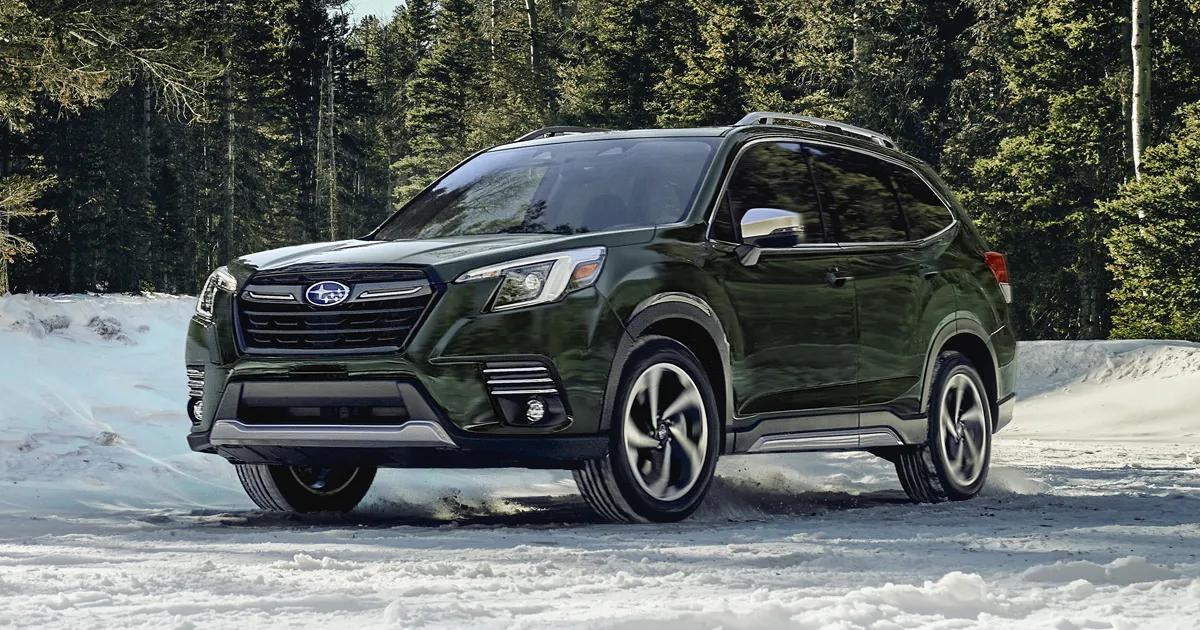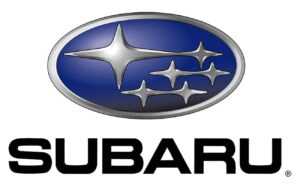 Subaru Forester 2023 Fuel Tank User Guide
Subaru Forester 2023 Fuel Tank User Guide
For many years, drivers looking for a competent and adaptable SUV have often chosen the Subaru Forester. Subaru has improved the gasoline tank of the Forester with the launch of the 2023 model, enhancing both its effectiveness and overall performance. The Subaru Forester’s fuel tank was modified in 2023 to enhance capacity and improve form. The capacity of the new tank has increased from the previous model’s 15.9 gallons to 16.6 gallons. With a larger fuel capacity, the Forester can go longer between fill-ups, improving convenience and practicality for daily usage. The larger gasoline tank has been designed to boost the Forester’s fuel economy in addition to its greater capacity. The tank’s design has been improved to lessen the quantity of petrol that sloshes about when the vehicle accelerates, decelerates, or corners. This makes the Forester more ecologically friendly by increasing fuel economy and lowering emissions. A better fuel delivery system is also included in the 2023 Subaru Forester. A more effective combustion process is achieved by the engine’s direct injection technology, which distributes fuel directly to the combustion chamber. This makes the Forester an even more eco-friendly option for drivers by increasing fuel efficiency and lowering pollutants. Performance is enhanced by the redesigned gasoline tank and delivery system for the Forester. The Forester is one of the most fuel-efficient SUVs in its class, with a combined city/highway fuel efficiency of 29 miles per gallon. Given that the Forester comes standard with all-wheel drive, which often lowers fuel efficiency in other cars, this efficiency is quite excellent. The Subaru Forester gas cap release 2022-2023 mechanism allows you to easily access the gas cap for refueling.
2023 Subaru Forester Specs, Price, Features, Mileage (Brochure)
Fuel
CAUTION
- The use of a fuel that is low in quality or the use of an inappropriate fuel additive may cause damage to the engine and/or fuel system.
- Some gas stations, particularly those in high-altitude areas, offer fuels posted as regular octane gasoline with an octane rating below 87 AKI (90 RON). Use of those fuels is not recommended.
Fuel requirements
The engine is designed to operate using unleaded gasoline with an octane rating of 87 AKI (90 RON) or higher.
Fuel octane rating
Using gasoline with a lower octane rating can cause persistent and heavy knocking, which can damage the engine. Do not be concerned if your vehicle sometimes knocks lightly when you drive up a hill or when you accelerate. Contact your SUBARU dealer if you use a fuel with the specified octane rating and your vehicle knocks heavily or persistently.
RON
This octane rating is the Research Octane Number.
AKI
This octane rating is the average of the Research Octane and Motor Octane numbers and is commonly referred to as the Anti Knock Index (AKI).
Unleaded gasoline
The neck of the fuel filler pipe is designed to accept only an unleaded gasoline filler nozzle. Under no circumstances should a leaded gasoline be used because it will damage the emission control system and may impair drivability and fuel economy.
Reformulated gasoline
SUBARU supports the use of reformulated gasoline when available. Reformulated gasoline has been blended to burn more cleanly and reduce vehicle emissions.
MMT
Some gasoline contains an octane-enhancing additive called MMT (Methylcyclopentadienyl Manganese Tricarbonyl). If you use such fuels, your emission control system performance may deteriorate and the CHECK ENGINE warning light/Mal-function indicator light may turn on. If this happens, return to your authorized SUBARU dealer for service. If it is determined that the condition is caused by the type of fuel used, repairs may not be covered by your warranty.
Gasoline for cleaner air
Your use of gasoline with detergent additives will help prevent deposits from forming in your engine and fuel system. This helps keep your engine in tune and your emission control system working properly and is a way of doing your part for cleaner air. If you continuously use high-quality fuel with the proper detergent and other additives, you should never need to add any fuel system cleaning agents to your fuel tank. Many gasolines are now blended with materials called oxygenates. Use of these fuels can also help keep the air cleaner. Oxygenated blend fuels, such as ethanol (ethyl or grain alcohol) may be used in your vehicle but should contain no more than 10% ethanol for the proper operation of your SUBARU. Do not use any gasoline that contains more than 10% ethanol, including from any pump labeled, E15, E30, E50 or E85 (which are only some examples of fuel containing more than 10% ethanol). In addition, some gasoline suppliers are now producing reformulated gasoline, which are designed to reduce vehicle emissions. SUBARU approves the use of reformulated gasoline. If you are not sure what the fuel contains, you should ask your service station operators if their gasoline contains detergents and oxygenate and if they have been reformulated to reduce vehicle emissions. As additional guidance, only use fuels suited for your vehicle as explained in the following description.
- Fuel should be unleaded and have an octane rating no lower than that specified in this manual.
- Methanol (methyl or wood alcohol) is sometimes mixed with unleaded gasoline. Methanol can be used in your vehicle ONLY if it does not exceed 5% of the fuel mixture AND if it is accompanied by sufficient quantities of the proper solvents and corrosion inhibitors required to prevent damage to the fuel system. Do not use fuel containing methanol EXCEPT under these conditions.
- If undesirable driveability problems are experienced and you suspect they may be fuel-related, try a different brand of gasoline before seeking service at your SUBARU dealer.
- Fuel system damage or driveability problems that result from the use of improper fuel are not covered under the SUBARU Limited Warranty.
CAUTION
Do not let fuel spill on the exterior surfaces of the vehicle. Because fuel may damage the paint, be sure to wipe off any spilled fuel quickly. Paint damage caused by spilled fuel is not covered under the SUBARU Limited Warranty.
Fuel filler lid and cap
Locations of the fuel filler lid
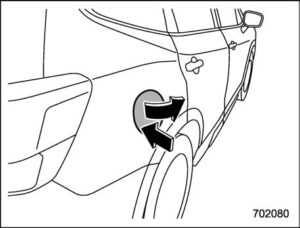 Refuelling
Refuelling
Only one person should be involved in refueling. Do not allow others to approach the area of the vehicle near the fuel filler pipe while refueling is in progress. Be sure to observe any other precautions that are posted at the service station.
- Before refueling, stop the vehicle, then turn off the ignition switch to turn off all the electrical components. At this time, the fuel filler lid also unlocks.
NOTE
When you lock the door, the fuel filler lid also locks. To unlock the fuel filler lid, perform one of the operations below.- Press the unlock button on the key fob.
- Press the unlock side of the power door locking switch.2. Push the rear side of the fuel filler lid.
- The fuel filler lid opens automatically.
- Open it further by hand.
WARNING
Before opening the fuel filler cap, first touch the vehicle body or a metal portion of the fuel pump or similar object to discharge any static electricity that may be present on your body. If your body is carrying an electrostatic charge, there is a possibility that an electric spark could ignite the fuel, which could burn you. To avoid acquiring a new static electric charge, do not get back into the vehicle while refuelling is in progress.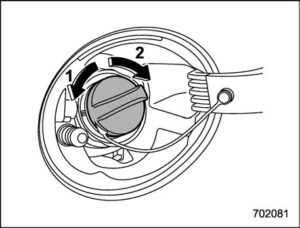
- Open
- Close
- Remove the fuel filler cap by turning it slowly counterclockwise.
WARNING
- Gasoline vapor is highly flammable. Before refueling, always turn the ignition switch to the “LOCK”/“OFF” position first and then close all vehicle doors and windows. Make sure that there are no lighted cigarettes, open flames or electrical sparks in the adjacent area. Only handle fuel outdoors. Quickly wipe up any spilled fuel.
- When opening the cap, grasp it firmly and turn it slowly to the left. Do not remove the cap quickly. Fuel may be under pressure and spray out of the fuel filler neck, especially in hot weather. If you hear a hissing sound while you are removing the cap, wait for the sound to stop and then slowly open the cap to prevent fuel from spraying out and creating a fire hazard.

- Set the fuel filler cap on the cap holder inside the fuel filler lid.
WARNING- When refueling, insert the fuel nozzle securely into the fuel filler pipe. If the nozzle is lifted or not fully inserted, its automatic stopping mechanism may not function, causing fuel to overflow the tank and creating a fire hazard.
- Stop refueling when the automatic stop mechanism on the fuel nozzle activates. If you continue to add fuel, the temperature
changes or other conditions may cause fuel to overflow from the tank and create a fire hazard.
- Stop filling the tank after the fuel filler pump automatically stops. Do not add any more fuel.
- Put the cap back on and turn it clockwise until you hear a clicking noise. Be certain not to catch the tether under the cap while tightening.
CAUTION
Make sure that the cap is tightened until it clicks to prevent fuel spillage in the event of an accident. - Close the fuel filler lid completely.
CAUTION
If you spill any fuel on the painted surface, rinse it off immediately. Otherwise, the painted surface could be damaged.
NOTE.
You will see the “ ” sign in the fuel gauge. This indicates that the fuel filler door (lid) is located on the right side of the vehicle.
- If the fuel filler cap is not tightened until it clicks or if the tether is caught under the cap, the CHECK ENGINE warning light/malfunction indicator light may illuminate. Refer to “CHECK ENGINE warning light/Malfunction indicator light”
- To lock the fuel filler lid, perform one of the operations below. However, if these operations are performed when the fuel filler lid is open, the fuel filler lid will not lock when it is subsequently closed.
- Press the lock/arm button on the key fob.
- Press the lock side of the power door locking switch.
- When the doors are locked or unlocked using the automatic door lock system, the fuel filler lid will be locked or unlocked at the same time.
CAUTION
Never add any cleaning agents to the fuel tank. The addition of a cleaning agent may cause damage to the fuel system.
- After refueling, turn the cap to the right until it clicks to ensure that it is fully tightened. If the cap is not securely tightened, fuel may leak out while the vehicle is being driven or fuel spillage could occur in the event of an accident, creating a fire hazard.
- Do not let fuel spill on the exterior surfaces of the vehicle. Because fuel may damage the paint, be sure to wipe off any spilled fuel quickly. Paint damage caused by spilled fuel is not covered under the SUBARU Limited Warranty.
- Always use a genuine SUBARU fuel filler cap. If you use the wrong cap, it may not fit or have proper venting and your fuel tank
and emission control system may be damaged. It could also lead to fuel spillage and a fire. - Immediately put fuel in the tank whenever the low fuel warning light illuminates. Engine misfires as a result of an empty tank could cause damage to the engine. Continuing to operate your vehicle at an extremely low fuel level may result in a reduction of engine performance.
If the fuel filler lid cannot be opened
If the fuel filler lid cannot be opened due to malfunction or a dead battery, it can be opened from the cargo area.
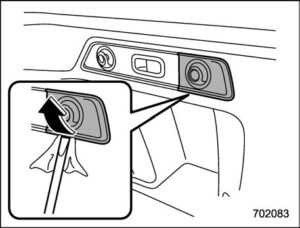
- Remove the access cover at the right side of the cargo area trim using a flathead screwdriver.
 Clip
Clip - Remove the orange knob from the clip.
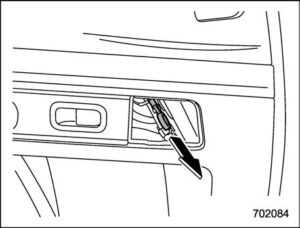
- Pull the orange knob to unlock the fuel filler lid.
State emission testing (U.S. only)
WARNING
Only use a four-wheel dynamometer when testing an All-Wheel Drive model. Testing of an AWD model must NEVER be performed on a single two-wheel dynamometer. Attempting to do so will result in uncontrolled vehicle movement and may cause an accident or injuries to persons nearby.
CAUTION
- At state inspection time, remember to tell your inspection or service station in advance not to place your SUBARU AWD vehicle
on a two-wheel dynamometer. Otherwise, serious transmission damage will result. - Resultant vehicle damage due to improper testing is not covered under the SUBARU Limited Warranty and is the responsibility of the state inspection program or its contractors or licensees.
- California and a number of federal states have Inspection/Maintenance programs to inspect your vehicle’s emission control system. If your vehicle does not pass this test, some states may deny renewal of your vehicle’s registration.
Your vehicle is equipped with a computer that monitors the performance of the engine’s emission control system. Certified emission inspectors will inspect the onboard diagnostic (OBDII) system as part of the state emission inspection process. The OBDII system is designed to detect engine and transmission problems that might cause vehicle emissions to exceed allowable limits. OBDII inspections apply to all 1996 model year and newer passenger cars and trucks. Over 30 states plus the District of Columbia have implemented emission inspection of the OBDII system. - The inspection of the OBDII system consists of a visual operational check of the “CHECK ENGINE” warning light/
malfunction indicator light (MIL) and an examination of the OBDII system with an electronic scan tool. - A vehicle passes the OBDII system inspection if proper operation of the “CHECK ENGINE” warning light is observed, there are no stored diagnostic trouble codes, and the OBDII readiness monitors are all complete.
- A vehicle fails the OBDII inspection if the “CHECK ENGINE” warning light is not properly operating (the light is illuminated
or is not working due to faulty LED [Light Emitting Diode]) or there is one or more diagnostic trouble codes stored in the vehicle’s computer. - A state emission inspection may reject (not pass or fail) a vehicle if the number of OBDII system readiness monitors “NOT READY” is greater than one. If the vehicle’s battery has been recently replaced or disconnected, the OBDII system inspection may indicate that the vehicle is not ready for the emission test. Under this condition, the vehicle driver should be instructed to drive his/ her vehicle for a few days to reset the readiness monitors and return for an emission re-inspection.
- Owners of rejected or failing vehicles should contact their SUBARU dealer for service.
Some states still use dynamometers in their emission inspection program. A dynamometer is a treadmill or roller-like testing device that allows your vehicle’s wheels to turn while the vehicle remains in one place. Prior to your vehicle being put on a dynamometer, tell your emission inspector not to place your SUBARU AWD vehicle on a two-wheel dynamometer. Otherwise, serious transmission damage will result.
The U.S. Environmental Protection Agency (EPA) and states using two-wheel dynamometers in their emission testing program have EXEMPTED SUBARU AWD vehicles from the portion of the testing program that involves a two-wheel dynamometer. There are some states that use four-wheel dynamometers in their testing program. When properly used, this equipment should not damage a SUBARU AWD vehicle. Under no circumstances should the rear wheels be jacked off the ground, nor should the driveshaft be disconnected in an attempt to bypass AWD for state emission testing. An AWD vehicle must be tested using an AWD dynamometer with all 4 wheels driven and loaded.
Preparing to drive
You should perform the following checks and adjustments every day before you start driving.
- Check that all windows, mirrors, and lights are clean and unobstructed.
- Check the appearance and condition of the tires. Also check tires for proper inflation.
- Look under the vehicle for any sign of leaks.
- Check that no small animals enter the engine compartment.
- Check that the hood and rear gate are fully closed.
- Check the adjustment of the seat.
- Check the adjustment of the inside and outside mirrors.
- Fasten your seatbelt. Check that your passengers have fastened their seatbelts.
- Check the operation of the warning and indicator lights when the ignition switch is turned to the “ON” position.
- Check the gauges, indicator and warning lights after starting the engine.
CAUTION
Trapping small animals in the cooling fan and belt of the engine may result in a malfunction. Check that no small animal enters the engine compartment or under the vehicle before starting the engine.
NOTE
- Engine oil, engine coolant, brake fluid, washer fluid and other fluid levels should be checked daily, weekly or at fuel stops.
- When towing a trailer, refer to “Trailer hitch (dealer option)”
Starting and stopping the engine (models without pushbutton start system)
CAUTION
Do not operate the starter motor continuously for more than 10 seconds. If the engine fails to start after operating the starter for 5 to 10 seconds, wait for 10 seconds or more before trying again.
NOTE
It may be difficult to start the engine when the battery has been disconnected and reconnected (for maintenance or other purposes). This difficulty is caused by the electronically controlled throttle’s self-diagnosis function. To overcome it, keep the ignition switch in the “ON” position for approximately 10 seconds before starting the engine.
Starting engine
General precautions when starting the engine
WARNING
- Never start the engine from outside the vehicle (except when using the remote engine start system). It may result in an accident.
- Do not leave the engine running in locations with poor ventilation, such as a garage and indoors. The exhaust gas may enter the vehicle or indoors, and it may result in carbon monoxide poisoning.
- Do not start the engine near dry foliage, paper, or other flammable substances. The exhaust pipe and exhaust emissions can create a fire hazard at high temperatures.
CAUTION - If the engine is stopped while driving, the catalyst may overheat and burn.
- When starting the engine, be sure to sit in the driver’s seat (except when using the remote engine start system).
NOTE
- Avoid rapid racing and rapid acceleration immediately after the engine has started.
- After the engine starts, the engine speed will be kept high.
- On rare occasions, it may be difficult to start the engine depending on the fuel and the usage condition (repeated driving of a distance in which the engine has not warmed up sufficiently). In such a case, it is recommended that you change to a different brand of fuel.
- On rare occasions, transient knocking may be heard from the engine when the accelerator is operated rapidly such as a rapid start-up and a rapid acceleration. This is not a malfunction.
- The engine starts more easily when the headlights, air conditioner and rear window defogger are turned off.
- Do not shift the select lever while the starter is cranking.
- Apply the parking brake.
- Turn off unnecessary lights and accessories.
- Shift the select lever to the “P” or “N” position (preferably the “P” position). The starter motor will only operate when the select lever is at the “P” or “N” position.
- Turn the ignition switch to the “ON” position and check the operation of the warning and indicator lights.Turn the ignition switch to the “START” position without depressing the accelerator pedal. Release the key immediately
after the engine has started. If the engine does not start, try the following procedure. - Turn the ignition switch to the “LOCK”/“OFF” position and wait for at least 10 seconds. After checking that the parking brake is firmly set, turn the ignition switch to the “START” position while depressing the accelerator pedal slightly (approximately a quarter of the full stroke). Release the accelerator pedal as soon as the engine starts.
- If this fails to start the engine, turn the ignition switch back to the “LOCK”/“OFF” position and wait for at least 1seconds. Then fully depress the accelerator pedal and turn the ignition switch to the “START” position. If the engine starts, quickly release the accelerator pedal.
- If this fails to start the engine, turn the ignition switch again to the “LOCK”/“OFF” position. After waiting for 10 seconds or longer, turn the ignition switch to the “START” position without depressing the accelerator pedal.
- If the engine still does not start, contact your nearest SUBARU dealer for assistance.
- Confirm that all warning and indicator lights have turned off after the engine has started. The fuel injection system automatically lowers the idle speed as the engine warms up.
While the engine is warming up, make sure that the select lever is in the “P” or “N” position and that the parking brake is applied.
CAUTION
If you restart the engine while the vehicle is moving, shift the select lever into the “N” position. Do not attempt to place the select lever of a moving vehicle into the “P” position.
Stopping the engine
The ignition switch should be turned off only when the vehicle is stopped and the engine is idling.
WARNING
Do not stop the engine when the vehicle is moving. This will cause loss of power to the power steering and the brake booster, making steering and braking more difficult. It could also result in accidental activation of the “LOCK”/“OFF” position on the ignition switch, causing the steering wheel to lock.
Steering lock
After stopping the engine and the key is removed from the ignition switch, the steering wheel will be locked due to the steering lock function. When the engine is restarted, the steering lock will be automatically released.
When the steering lock cannot be released
When you cannot unlock the steering wheel, perform the following steps. 1. Check that the parking brake is applied.
Steering lock
After stopping the engine and any door including the rear gate is opened, the steering wheel will be locked due to the steering lock function. When the engine is restarted, the steering lock will be automatically released.
When the steering lock cannot be released
- Operation indicator
- Push-button ignition switch
When you cannot restart the engine due to the steering lock, check the status of the operation indicator and perform the following steps.
Operation indicator flashing in green
- Check that the select lever is set in the “P” position.
- Depress the brake pedal and keep it
- Press the push-button ignition switch
while turning the steering wheel left and right.
Operation indicator flashing in orange
There may be a malfunction in the steering lock function. Immediately contact your nearest SUBARU dealer.
FAQ
What size gasoline tank does the 2023 Subaru Forester have?
The Subaru Forester 2023 has a 15.9-gallon fuel tank capacity.
What kind of gasoline is used by the Subaru Forester 2023?
Regular unleaded gasoline is what the Subaru Forester 2023 runs on.
How far can the Subaru Forester 2023 be driven before needing a refill?
Depending on the road and traffic conditions, the Subaru Forester 2023’s estimated range on a full tank of petrol is 448 miles.
If the gasoline tank is broken, can it be replaced?
Yes, if the gasoline tank is damaged, it may be replaced. It is advised, nevertheless, that you take your car to a Subaru dealer who is certified to do this service.
How often should I refuel the Subaru Forester 2023?
Depending on driving patterns and road conditions, this might vary, but generally speaking, the gasoline tank has to be topped up every 300 to 400 miles.
Does the Subaru Forester 2023 have a fuel filter?
The Subaru Forester 2023 does indeed include a fuel filter, which aids in maintaining a clean and debris-free fuel system.
How often should a gasoline filter be changed?
Every 30,000 miles, the Subaru Forester 2023’s gasoline filter has to be changed.
The gasoline tank has a warranty, right?
Yes, the Subaru Forester 2023’s warranty, which is valid for 3 years or 36,000 miles, whichever comes first, covers the gasoline tank.
Can I fuel the Subaru Forester 2023 with E85?
The Subaru Forester 2023 is not intended to use E85 as gasoline, therefore no. Use unleaded normal gasoline with an octane value of 87 or higher, as advised.
How will I know when the gasoline is almost gone?
When the gasoline tank is almost empty, the instrument cluster’s fuel gauge will make the necessary announcement. On the dashboard, a low fuel warning light will also come on.
Can I expand the Subaru Forester 2023’s fuel tank capacity?
No, it is not advised to change the Subaru Forester 2023’s fuel tank capacity. The vehicle’s performance and safety may be jeopardized if you do this.
How long does it take to fill the Subaru Forester 2023’s gasoline tank?
The Subaru Forester 2023’s petrol tank fills up in an average of 5 to 10 minutes, however, this might vary depending on the fuel pump and other elements.
Can the gasoline tank top on a Subaru Forester 2023 be locked?
In order to increase security, the Subaru Forester 2023’s fuel tank lid may be secured.
How do I remove the cover from the gasoline tank on a Subaru Forester 2023?
Find the gasoline filler door release lever on the lower left side of the driver’s seat, and pull it up to open the fuel tank cap. The gasoline tank cap should then be removed by turning it counterclockwise.
Is the Subaru Forester 2023’s fuel tank prone to rusting?
The Subaru Forester 2023’s fuel tank is composed of materials that resist corrosion and won’t rust.
How to open gas tank on Subaru Forester?
subaru forester gas tank open button 2023, locate the fuel door release lever inside the vehicle, typically near the driver’s seat. Pull or push the lever to release the fuel door, then push the door open manually to access the gas cap. After refuelling, securely close the gas cap and push the fuel door closed until it clicks into place.
Useful Link
View Full User Guide: Subaru Forester 2023 Base User Guide | Auto User Guide
2023 Subaru Forester Specs, Price, Features, Mileage (Brochure)

